1996 PONTIAC GRAND-AM parking brake
[x] Cancel search: parking brakePage 188 of 356
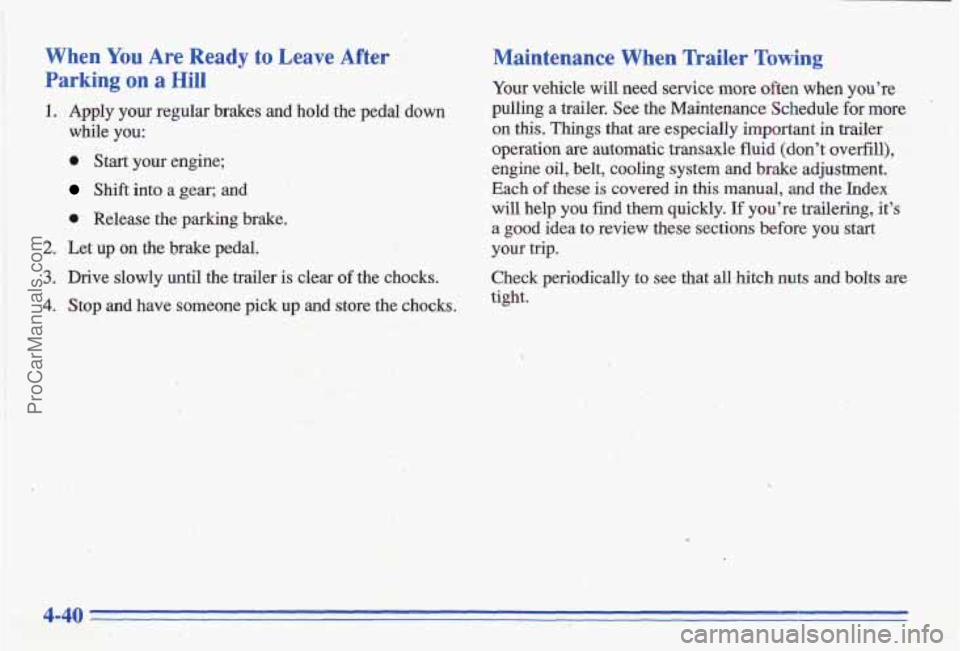
When You Are Ready to Leave After
Parking on a Hill
1. Apply your regular brakes and hold,the pedal down
while
you:
0 Start your engine;
Shift into a gear; and
I. Release the parking brake.
2. Let up on the brake pedal..
3. Drive slowly until the trailer is clear of the chocks.
4. Stop and have someone pick up and store the chocks.
Maintenance When Trailer Towing
Your vehicle will need service more often when you're
pulling a trailer. See the Maintenance Schedule for more
on this. Things that are especially important in trailer
operation are automatic transaxle
fluid (don't ovel-fill),
engine oil, belt, cooling system and brake adjustment.
Each of these is covered in this manual, and the Index
will
help you find them quickly. If you're trailering, it's
a good idea to review these sections before you start
<* ~ I ,,; ;-':'. .a t , ,--: .. ;::l.$.:$ 5
Check periodically to see that all hitch nuts and bolts are
tight.
your trip. ! . .i . :$ ,,- .,,. . . f ~
_I.,
4-40
ProCarManuals.com
Page 193 of 356
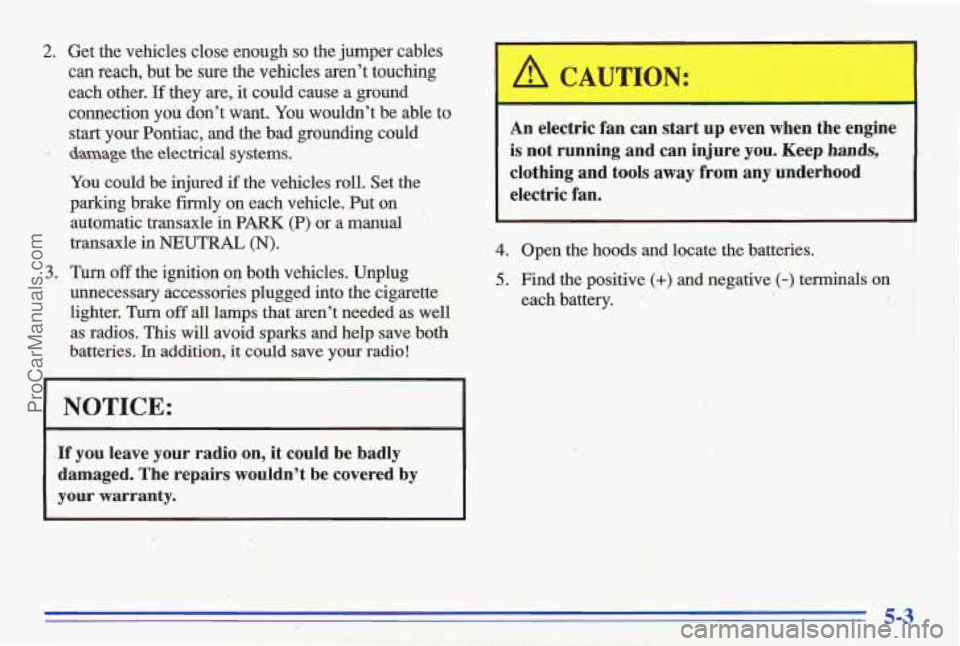
2. Get the vehicles close enough so the jumper cables
can reach, but be sure the vehicles aren’t touching
each other.
If they are, it could cause a ground
connection
you don’t want. You woulddt be able to
start your Pontiac, and the bad grounding could
You could be injured if the vehicles roll. Set the
parking brake firrnly on each vehicle. Put on automatic transaxle in
PARK (P) or a manual
transaxle
in NEUTRAL (N).
1 damage the electrical systems.
3. Turn off the ignition on both vehicles. Unplug
unnecessary accessories plugged into the cigarette lighter.
Turn off all lamps that aren’t needed as well
as radios. This will avoid sparks and help save both
batteries. In addition,
it could save your radio!
I NOTICE:
.If you leave your radio on, it could be badly
damaged. The repairs wouldn’t be covered
by
your warranty.
An electric fan can start up even when the engine
is not running and can injure
you. Keep hands,
clothing and tools.away from any underhood electric fan.
4. Open the hoods and locate the batteries.
5. Find the positive (+) and negative (-) terminals on
each battery.
5-3
ProCarManuals.com
Page 198 of 356
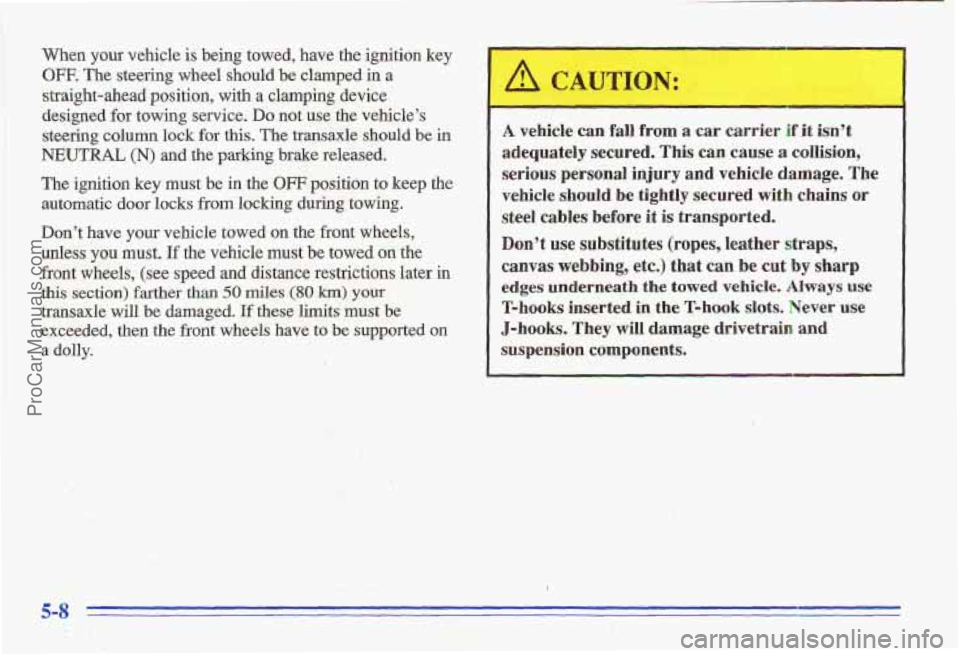
When your vehicle is being towed, have the ignition key
OFF. The steering wheel should be clamped in a
straight-ahead position, with
a clamping device
designed for towing service. Do not use the vehicle's
steering column lock
for this. The transaxle should be in
NEUTRAL (N) and the parking brake released.
The ignition key must be in the
OFF position to keep the
automatic
door locks from locking during towing.
Don't have your vehicle towed on the front wheels,
unless
you 'must. If the vehicle must be towed on the
front wheels,' (see speed and distance restrictions
later in
this section) farther than 50 miles (80 km) your
transaxle will be damaged. If these limits must be
exceeded, then
the front wheels have to be supported on
a
dolly.
r
A vehicle can fall from a car carr if it isn't
adequately secured.
This can cause a collision,
1 serious personal injury and vehicle damage. The
' vehicle should be tightly secured with chains or
steel cables before it is transported.
Don't use substitutes (ropes, leather straps,
canvas webbing, etc.) that can
be cut by sharp
edges underneath the towed vehicle. Always use
T-hooks inserted in the T-hook slots. Never use
J-hooks. They will damage drivetrain and
suspension components.
ProCarManuals.com
Page 211 of 356
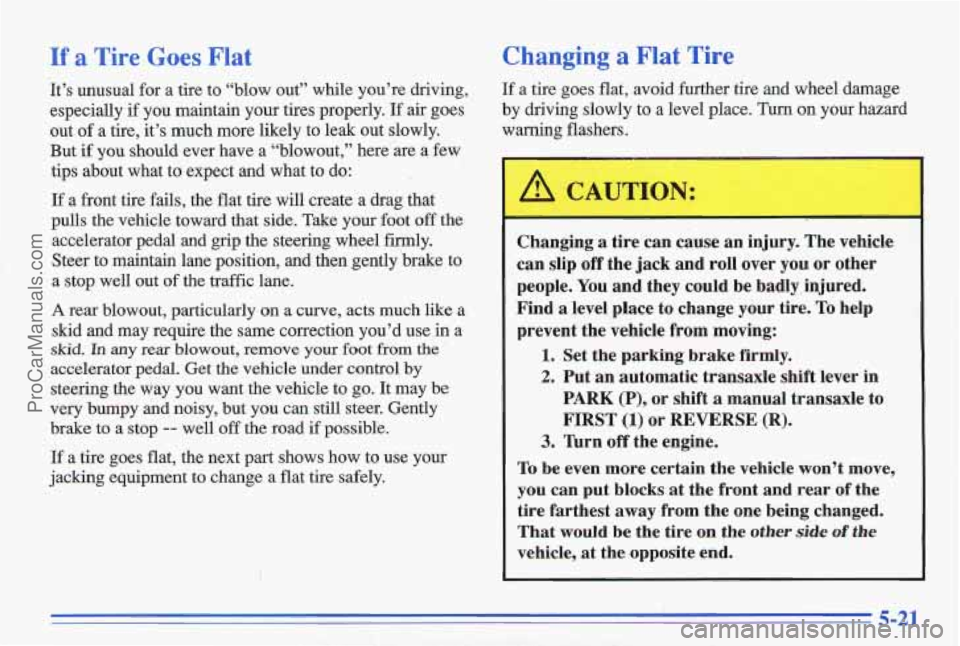
If a Tire Goes Flat
It’s unusual for a tire to “blow out” while you’re \
driving,
especially
if you maintain your tires properly. If air goes
out
of a tire, it’s much more likely to leak out slowly.
But
if you should ever have a “blowout,” here are a few
tips about what to expect and what to
do:
If a front tire fails, the flat tire will create a drag that
pulls the vehicle toward that side. Take your foot off the
accelerator pedal and grip the steering wheel firmly.
Steer
to maintain lane position, and then gently ‘brake to
a stop well out
of the traffic lane.
A rear blowout, particularly on a curve, acts much like a
skid and may require the same correction you’d use in a
skid. In my rear blowout, remove your foot from the
accelerator pedal. Get the vehicle under control by
steering the way you want the vehicle to
go. It may be
very bumpy and noisy, but you can
still steer. Gently
brake to a stop
-- well off the road if possible.
If a tire goes flat, the next part shows how to use your
jacking equipment to change a flat tire safely.
Changing a Flat Tire
If a tire goes flat, avoid further tire and wheel damage
by driving slowly
to a level place. Turn on your hazard
warning flashers.
Changing a tire can cause an injury. The vehicle
can slip
off the jack and roll over you or other
people.
You and they could be badly,injured.
Find
a level place to change your tire. To help
prevent the vehicle from moving:
1. Set the parking brake firmly.
2. Put an’automatic transaxle shift lever in
PARK
(P), or shift a manual transaxle to
FIRST (1) or REVERSE (R).
3. lbrn off the engine.
To be even more certain the vehicle won’t move,
you can put blocks at the front and rear of the
tire farthest away from the one being changed.
That would be the tire
on the other side of the
vehicle, at the opposite end.
5-21
ProCarManuals.com
Page 240 of 356

Checking the Fluid Level
' Park your vehicle on a level place. Keep the engine
running.
With the parking brake applied, place the shift lever
in
PARK (P). I
With your foot on the brake pedal, move the shift
lever through each
gear range, pausing for about
three seconds in each range. Then, position the shift
lever in PARK (P).
0 Let the engine run at idle for three to five minutes. Then,
without shutting
off the engine, follow these
steps:
1. The automatic transaxle dipstick handle is red. Pull
out the dipstick
and wipe it with a clean rag or paper
towel.
2. hsh it back in all the way, wait three seconds and
then pull it back out again.
6-18
ProCarManuals.com
Page 278 of 356

Fuse
INT LPS
PWR
ST
RDO IGN
HTR-A/C
CRUISE
TAIL LPS
a Fuse Useage
PWR WDO Power Window (Circuit Breaker)
TURN Turn Signal Lamps
Useage
Alarm Module (Illuminated Entry,
Warning Chimes, Overhead
Lamps., MapJReading Lamps,
Glove Box Lamp, Trunk Lamp,
Radio, Power Mirrors), Anti-Lock
Brakes, Variable
Effort Steering,
Remote Keyless
Entry
Power Seat ?,,,. :. . . .- . - . .. .. Radi&-<-'&'.: ?.>I' ?;~-,~:-~~~,(l ,;,* , ' _. . . I' . &-:.*& . : ' . . I 8.. .~ . . .I d&
Heater/Air Conditioning Blower,
Daytime Running Lamps, Automatic Light Control
Cruise Control
Parking Lamps, Taillamps,
Sidemarker Lamps, License
Lamps, Instrument Panel Lights,
Headlamp
Warning Alarm
Cigarette Lighter
6-56
ProCarManuals.com
Page 322 of 356
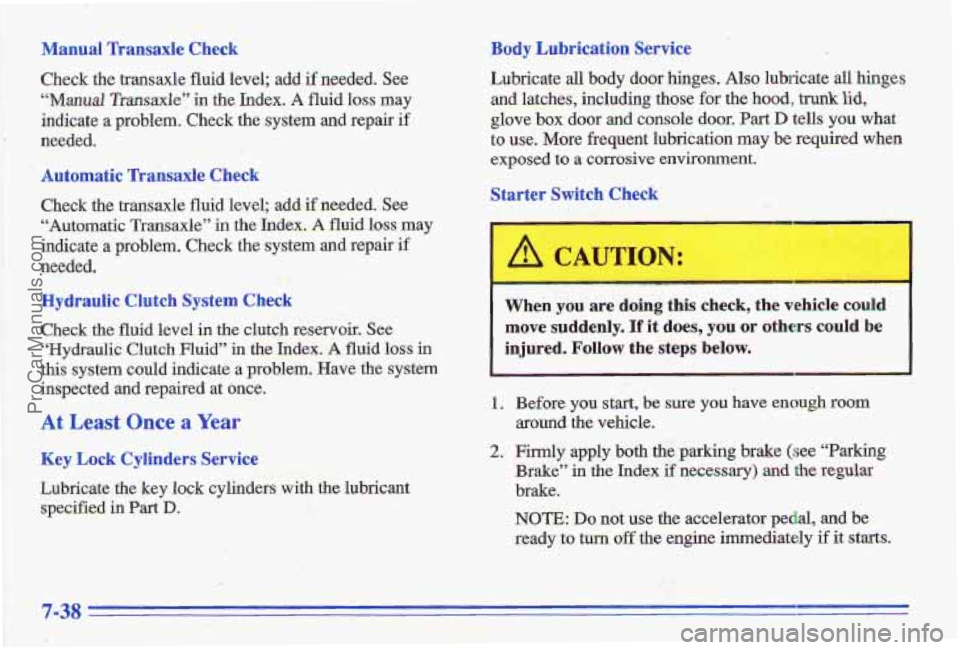
Manual Transaxle Check
Check the transaxl’e fluid level; add if needed. See
“Manual Transaxle” in the Index. A fluid loss may
indicate
a problem. Check the system and repair if
needed.
Automatic Transaxle Check
Check the transaxle fluid level; add if needed. See “Automatic Transaxle”
in the Index. A fluid loss may
indicate a problem. Check the system and repair if
needed.
Hydraulic Clutch System Check
Check the fluid level in the clutch reservoir. See
“Hydraulic Clutch
Fluid” in the Index. A fluid loss in
this system could indicate a problem. Have the system
inspected and repaired at once.
At Least Once a Year
Key Lock Cylinders Service
specified in Part D.
1
’ Lubricate the key lock cylinders with the lubricant
Body Lubrication Service
Lubricate all body door hinges. Also lubricate all hinges
and latches, including those for the hood, tmnk lid,
glove box door and console door. Part D tells you what .
to use. More frequent lubrication may be required when
exposed to a corrosive environment.
Starter Switch Check
A CAUT~ON:
,/ *
- “
When you are doing this check, the vehicle could
move suddenly. If it does, you or others could be
injured. Follow the steps below.
1.
2.
Before you start, be sure you have enough room
around the vehicle.
Firmly apply both the parking brake
(see “Parking
Brake” in the Index if necessary) and the regular
brake.
NOTE: Do not use the accelerator pedal, and be
ready to
turn off the engine immediately if it starts.
ProCarManuals.com
Page 323 of 356
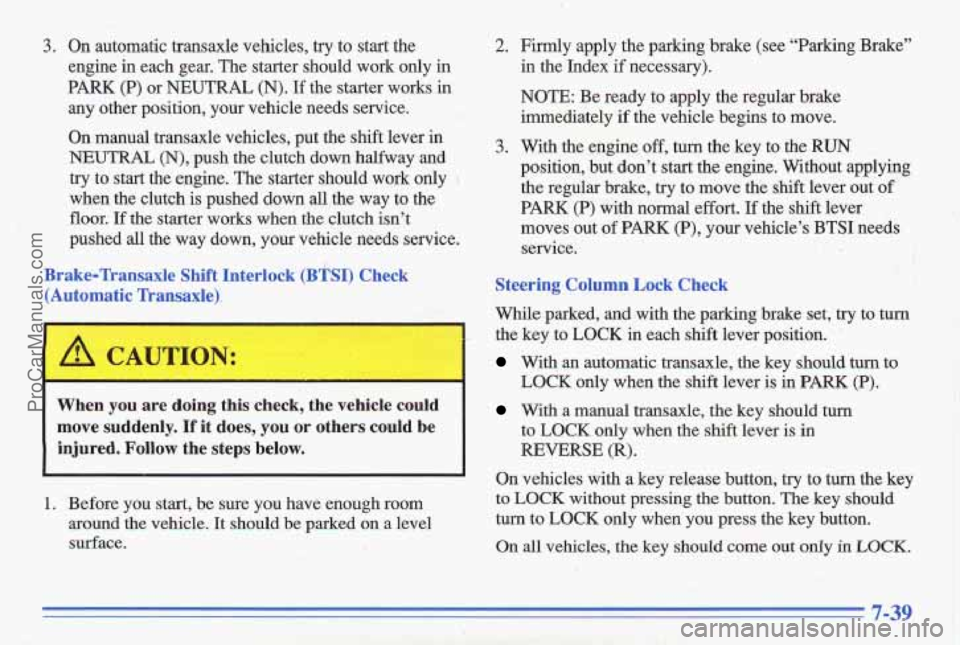
3.
,.
- ‘1 . -
On automatic transaxle vehicles, try to start the
engine in each gear. The starter should work only in
PARK (P) or NEUTRAL
(N). If the starter works in
any other position, your vehicle needs service.
On manual transaxle vehicles, put the shift lever in
NEUTRAL (N), push the clutch down halfway and
try to start the engine. The starter should work only
‘bt
when the clutch is pushed down all the way to the
floor. If the starter works when the clutch isn’t
.. .. I ’ . . . i. pushed all the way down, your vehicle needs service.
Brake-Transaxle Shift Interlock (BTSI) Check
(Automatic Transaxle),
’. n . .I .L I . I_ , .:
When you ald d,,,rg this check, the vehicle could
move suddenly. If it does,
you or others could be
injured. Follow the steps below.
1. Before you start, be sure you have enough room
around the vehicle.
It should be parked on a level
surface,
..A +
., .. ,. 1 f‘ .1
2.
3.
Firrnly apply the parking brake (see “Parking Brake”
in the Index
if necessary).
NOTE: Be ready to apply the regular brake immediately if the vehicle begins to move.
With the engine off, turn the key to the RUN
position, but don’t start the engine. Without applying
the regular brake, try to move the shift lever out
of
PARK (P) with normal effort. If the shift lever
moves out of
PARK (P), your vehicle’s BTSI needs
service.
Steering Column Lock Check
While parked, and with the parking brake set, try to turn
the key to
LOCK in each shift lever position.
With an automatic transaxle, the key should turn to
LOCK only when the shift lever is in PARK (P).
With a manual transaxle, the key should turn
to
LOCK only when the shift lever is in
REVERSE (R).
On vehicles with a key release button, try to turn the key
to
LOCK without pressing the button. The key should
turn to LOCK only when you press the key button.
On
all vehicles, the key should come out only in LOCK.
7-39
ProCarManuals.com